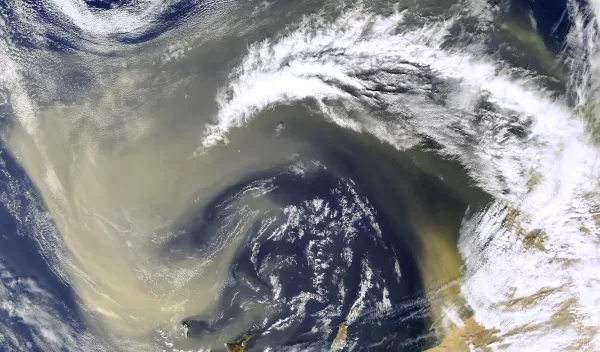
Earth's atmosphere far dustier than previously believed
Dust is a key component of Earth's climate system. When it interacts with clouds, oceans and the sun's radiation, it has an impact on our planet's living systems, affecting everything from weather and rainfall to global warming.
There are two types of dust in the atmosphere, both kicked up by high-velocity winds in dry areas. Fine dust tends to lead to cooling because it scatters sunlight, much like clouds do. Coarse dust, which is larger and originates in places such as the Sahara Desert, tends to warm the atmosphere, much like greenhouse gases.
Knowing how much coarse dust is in the atmosphere is essential for understanding not only the atmospheric phenomena dust influences, but also the degree to which dust may be warming the planet.
Now, UCLA scientists report that there is four times the amount of coarse dust in Earth's atmosphere than is currently simulated by climate models. The findings appear in the journal Science Advances.
The National Science Foundation-funded researchers found that Earth's atmosphere contains 17 million metric tons of coarse dust -- the equivalent of 17 million elephants, or the mass of every person in America, put together.
"To properly represent the impact of dust as a whole on the Earth system, climate models must include an accurate treatment of coarse dust in the atmosphere," said the study's first author, Adeyemi Adebiyi.
Adebiyi worked with Jasper Kok, a UCLA atmospheric and ocean scientist, to determine the actual amount of coarse dust in the atmosphere by analyzing dozens of published aircraft-based observations, including recent measurements taken over the Sahara Desert, and comparing those with widely used global atmospheric model simulations.
"When we compared our results with what is predicted by current climate models, we found a drastic difference," Kok said. "State-of-the-art climate models account for only 4 million metric tons, but our results showed more than four times that amount."
By plugging this amount of missing coarse dust into models, Adebiyi said, it increases the likelihood that the net amount of dust overall -- both fine and coarse -- is warming rather than cooling the Earth's climate system, from air to oceans.
Coarse dust particles warm Earth's climate by absorbing both incoming radiation from the sun and outgoing radiation from Earth's surface. These particles can impact stability and circulation within our atmosphere, which may affect atmospheric phenomena like hurricanes.
"An accurate prediction of global climate change depends on understanding various components in the Earth system," says Chungu Lu, a program director in NSF's Division of Atmospheric and Geospace Sciences. "This research has furthered our understanding of climate change effects by dust, especially coarse dust, in the air."
